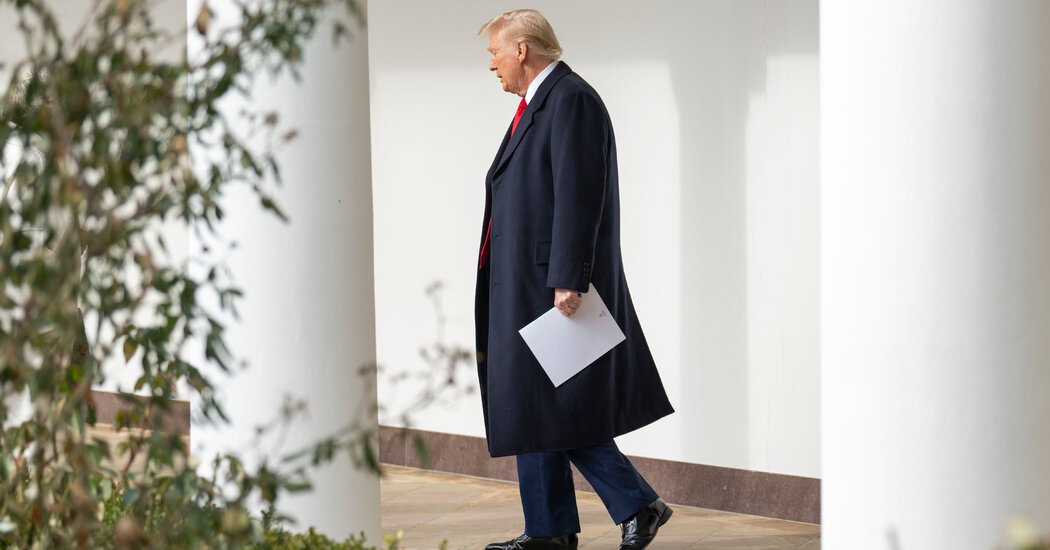Physical Address
304 North Cardinal St.
Dorchester Center, MA 02124
Physical Address
304 North Cardinal St.
Dorchester Center, MA 02124

The Trump administration plans to push for the renegotiation of US trade agreements with Canada and Mexico ahead of a required 2026 renegotiation, seeking to boost US auto jobs and counter Chinese companies that enters the Mexican car sector, common people say the deliberation.
The US-Mexico-Canada Agreement, which Mr. Trump signed in 2020, called for the three countries to conduct a “joint review” of the agreement after six years, on July 1, 2026. But Mr. Trump plans to start those negotiations sooner rather than later. , according to the people, who spoke on condition of anonymity to discuss plans that have not been made public.
Trump officials in particular want to tighten the rules governing the auto sector, to try to discourage car companies from leaving the United States, they said. They also seek to prevent Chinese auto and auto parts manufacturers from exporting to the United States through factories in Mexico.
Mr. Trump has also threatened to impose 25 percent tariffs on products from Canada and Mexico, saying those countries allow drugs and immigrants to flow across the U.S. border. During a speech in the Oval Office on Monday night after his inauguration, he said he planned to move forward with the fee on February 1.
Members of Trump’s team believe that Mexico has violated the terms of a separate agreement to limit metal exports to the United States, and they want to show the Mexican government that they want to take action against trade violations. that’s how they are, someone they’re familiar with. said the conversation.
The Wall Street Journal previously reported that Mr. Trump had pushed ahead with negotiations on the North American trade deal. The three countries must meet to discuss the terms of the trade deal six years after the agreement was signed, but trade experts hoped Trump’s team would speed up work on the issue. .
Mexico and Canada initially insisted on having six years before renegotiating terms of the deal because they thought it would bring them under a second consecutive Trump administration, a person familiar with the negotiations said. Instead, the requirements for talks in 2026 will fall in the lap of Mr. Trump.
Mr. Trump has long criticized the previous trade deal, the North American Free Trade Agreement, and officials have been negotiating a new deal to replace and renew it. One of the pact’s major changes was raising the threshold for a car’s interior that had to be produced in North America to qualify for zero tariffs. The agreement also included other provisions requiring the automaker to use North American metals and higher-quality workers.
But Mr. Trump and his advisers now think those measures are not restrictive enough to stop automakers from moving factories outside the United States. They were also wary of Mexican imports of cheap and high-end Chinese cars, as well as Chinese efforts to set up auto factories in Mexico.
Speaking at the Detroit Economic Club in October, Mr. Trump said that “Mexico has become a second China.”
“When China comes, they take everything, and you won’t have a car anymore,” he added.
People familiar with the plans cautioned that they could still change. It also remains to be seen whether Mr. Trump will threaten tariffs on Canada and Mexico as a negotiating tactic to remove some of his government’s concessions, or impose them outright. The Trump administration’s press office did not immediately respond to a request for comment.
Mr. Trump signed an executive order on Monday evening that directed various agencies to study various trade issues. He did not immediately impose new wages, as he had previously threatened, but the order confirmed the possibility of trade activity in the coming months.
One provision of the order directed trade officials to evaluate the impact of the North American trade agreement on workers, farmers and other businesses and “make recommendations on participation of the United States in the treaty.” They also ordered them to begin soliciting public comments in preparation for the July 2026 review of the trade agreement.